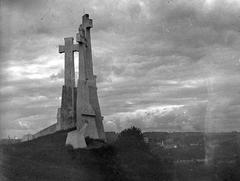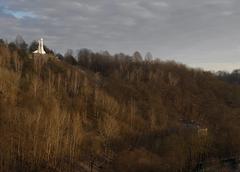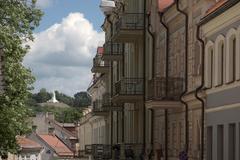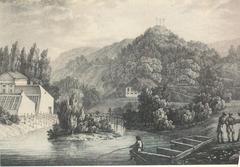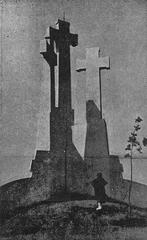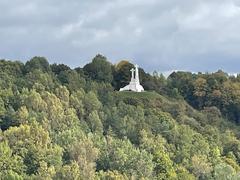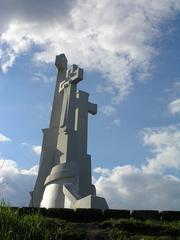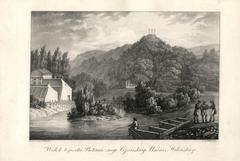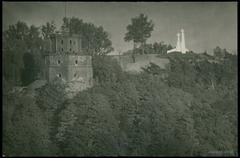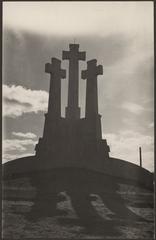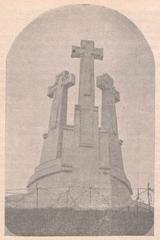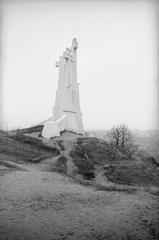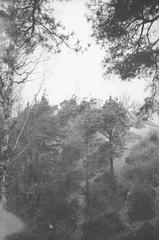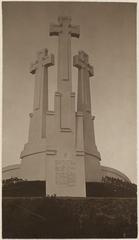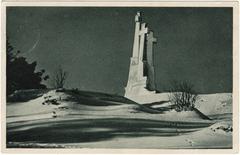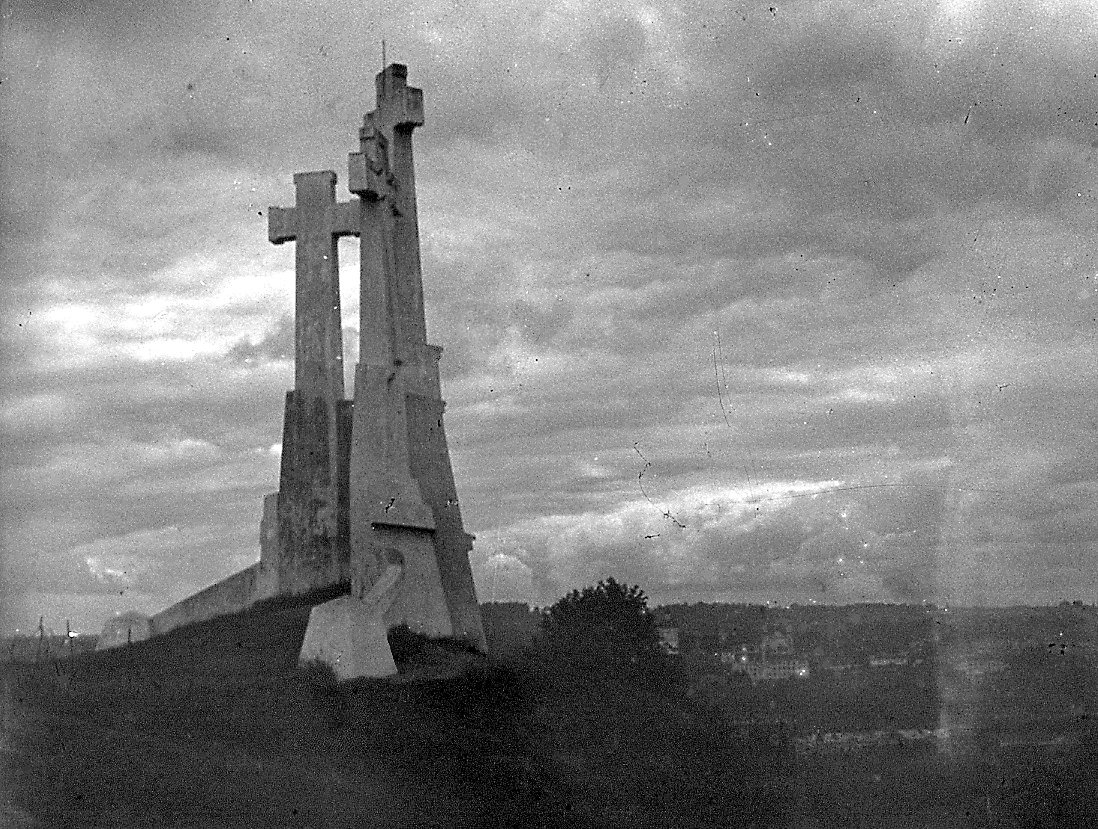
The Three Crosses of Vilnius: Visiting Hours, Tickets, and Historical Significance
Date: 14/06/2025
Introduction
The Three Crosses Monument in Vilnius is a powerful symbol of Lithuania’s endurance, faith, and national revival. Perched atop the Hill of Three Crosses (Trijų kryžių kalnas) in Kalnai Park, this landmark offers sweeping views of Vilnius and a compelling narrative woven from legend, religious history, and the country’s struggle for independence. From the martyrdom of Franciscan friars in the 14th century to Soviet destruction and the monument’s subsequent resurrection, the Three Crosses encapsulate the spirit of Lithuania.
This guide provides a detailed look at the monument’s history, national symbolism, and practical information for visitors—covering opening hours, ticketing, accessibility, transportation, nearby attractions, and tips for a memorable visit. Whether you’re a history enthusiast, photographer, or a traveler exploring Vilnius’s scenic highlights, understanding the story of the Three Crosses will deeply enrich your experience (Live the World, Vilnius Tourism, Lithuania Travel).
Table of Contents
- Introduction
- Historical Background
- Symbolism and National Significance
- Visiting the Three Crosses Monument
- Preservation and Remnants
- The Monument Today
- Frequently Asked Questions (FAQ)
- Conclusion
- References
Historical Background
Origins and Legends
The origins of the Three Crosses are steeped in legend and faith. According to the Bychowiec Chronicle, the monument commemorates the martyrdom of 14 Franciscan friars in the 14th century. These missionaries, invited to Vilnius, openly preached Christianity and were executed for their beliefs. The first wooden crosses are believed to have marked this site as early as the 17th century (Live the World).
Other stories suggest that the crosses were erected after Lithuania’s baptism or in gratitude for relief from a plague (WhiteMAD). Regardless of the precise origin, these tales have fused into the monument’s enduring identity.
Construction and Early History
Documented evidence shows that between 1613 and 1636, Franciscan monks built three wooden crosses atop what was then called Bald Hill. Over the centuries, the crosses decayed and were rebuilt multiple times. In the late 19th century, under Russian imperial rule, authorities forbade reconstruction, associating the site with Lithuanian national sentiment (WhiteMAD).
20th Century Transformations
World War I and Concrete Crosses
During the German occupation in World War I, permission was granted to rebuild the monument. In 1916, sculptor Antoni Wiwulski created a new version in reinforced concrete, which quickly became a city landmark.
Soviet Destruction
The crosses survived through the interwar years and World War II but were destroyed by Soviet authorities in 1950 in a campaign to suppress religious and national symbols (Isolated Traveller).
Restoration and Independence
With the rise of the Lithuanian Reform Movement in the late 1980s, the Three Crosses became a rallying symbol for independence. In 1989, the monument was rebuilt in just two weeks by architect Henrikas Šilgalis. The new design, slightly taller and lighter in color, was consecrated as a memorial to victims of Stalinism and a beacon of national revival (WhiteMAD).
Symbolism and National Significance
The Three Crosses are more than an architectural feature—they are a testament to Lithuania’s struggle, unity, and faith. The monument’s destruction and resurrection mirror the nation’s own history of oppression and renewal. Its visibility throughout Vilnius Old Town symbolizes national endurance and the city’s Christian heritage. Today, the monument is illuminated for national celebrations and international events, further cementing its status as a national icon (WhiteMAD, Isolated Traveller).
Visiting the Three Crosses Monument
Visiting Hours and Tickets
- Hours: The monument and Kalnai Park are open 24/7, year-round.
- Tickets: Visiting the site is free of charge; no tickets or reservations are needed (Vilnius Tourism, Compasses and Quests).
Getting There
- On foot: The most scenic route begins at Bernardine Gardens and takes about 15–20 minutes via stairs and forested trails.
- By public transport: Buses and trolleybuses stop near park entrances.
- By taxi/ride-sharing: Easily available—ask for drop-off near the park or Bernardine Gardens.
Accessibility
The approach to the monument involves steep and uneven paths with stairs, making it challenging for visitors with mobility impairments. The northern route via the park amphitheater is gentler but not fully accessible.
Best Time to Visit
- Sunrise and sunset: For the most dramatic panoramic views and photos.
- Evening: The monument is often illuminated, creating a striking scene.
- Seasonal highlights: Autumn foliage and winter snow add special atmosphere (Bucketlistly Blog).
Nearby Attractions
- Bernardine Gardens: Landscaped city park at the base of the hill.
- Kalnai Park: Trails, amphitheater, and additional viewpoints.
- Uzupis District: Bohemian neighborhood with street art and cafes.
- Vilnius Old Town: UNESCO World Heritage site with Vilnius Cathedral and Gediminas’ Tower.
Special Events & Guided Tours
The Three Crosses are a focal point for national holidays, religious processions, and commemorative illuminations. Many city walking tours include the monument—check with local operators for schedules (Lithuania Travel).
Photographic Tips
- Aim for golden hour (sunrise/sunset) for the best light.
- Use a wide-angle lens to capture both the crosses and the cityscape.
- Nighttime shots are especially atmospheric when the monument is lit.
Preservation and Remnants
The current monument’s foundations incorporate fragments of the Soviet-destroyed crosses. Larger remnants are displayed nearby, serving as a tangible reminder of the monument’s turbulent past (WhiteMAD).
The Monument Today
Today, the Three Crosses stand as a site of remembrance, reflection, and celebration. The summit’s panoramic terrace makes it a favorite gathering spot for both locals and visitors, offering unmatched views of Vilnius and its historic core (Evendo).
Frequently Asked Questions (FAQ)
Q: What are the visiting hours?
A: The monument and park are open 24/7 year-round.
Q: Is there an entrance fee?
A: No, entry is completely free.
Q: How do I get there from Vilnius city center?
A: Walk from Bernardine Gardens (15–20 minutes uphill), or use public transport or taxis to reach the park.
Q: Is the monument accessible for wheelchairs?
A: No, the paths are steep and have stairs.
Q: Are guided tours available?
A: Yes, many city tours include the monument.
Q: What is the best time to visit?
A: Early morning, late afternoon, or evening for the best light and views.
Conclusion
The Three Crosses Monument is a must-see for anyone exploring Vilnius. Free to visit and open all hours, it offers both a contemplative historical experience and some of the city’s best views. Plan your trip for sunrise or sunset, and combine your visit with nearby attractions for a rewarding day in Lithuania’s capital. For updates, guided tours, and further tips, consult the Audiala app and follow local tourism websites.
References
- The Legend of the Hill of Three Crosses in Vilnius, Live the World
- The Monument of the Three Crosses – One of the Most Recognisable Symbols of Vilnius, WhiteMAD
- 7 Interesting Facts About Three Crosses, Isolated Traveller
- Three Crosses Monument, Vilnius, Vilnius Tourism
- Three Crosses Monument, Lithuania Travel
- Visiting the Hill of Three Crosses, Compasses and Quests
- The Hill of Three Crosses, Go Vilnius
- The Three Crosses Monument in Vilnius: History, Tickets, and Travel Tips, Tom Solo Travels
- Vilnius Things to Do, Bucketlistly Blog
- Three Crosses Monument, Evendo
